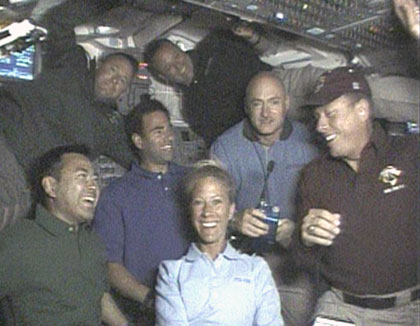Modified Shuttle Fuel Tank Performs Well, NASA Says

HOUSTON ? The modified fuel tank that fed the space shuttleDiscovery's main engines during its weekend launch performed well based on preliminary examinations, NASA officials saidSunday.
Discoverylaunched Saturday with the first external fuel tank built from scratch withall the changes planned after the 2003 Columbia disaster. The new tank wasdesigned to release as little falling debris as possible during launch, sincefalling foam from the external tank on Columbia damaged that orbiter?ssensitive heat shield and led to its demise.
?We worked very hard on the modifications that were inplace,? LeRoy Cain, STS-124?s mission management team chair, said in a briefinghere at Johnson Space Center on Sunday. ?We feel very good about theperformance of the tank.?
Discovery lifted off from NASA?s Kennedy Space Center inCape Canaveral, Fla. at 5:02 p.m. EDT (2102 GMT) on Saturday, carrying the JapaneseKibo laboratory to the International Space Station (ISS).
The seven STS-124crewmembers completed a preliminary scan of their vehicle?s heat tiling in somesensitive areas, such as the leading edges of its wings. The inspection hasn?tturned up any major problem areas so far, but the data still need to beanalyzed in detail.
"It was just a quick inspection, as much as we could with what we have," said mission specialist Karen Nyberg during a televised interview today.
The results of the survey, in combination withobservations and photos of Discovery?s external tank and orbiter during launch,indicate that the new design of the tank has been successful.
Get the Space.com Newsletter
Breaking space news, the latest updates on rocket launches, skywatching events and more!
?We do have a couple areas where we lost some foam, andwe?re still doing some analysis,? Cain said. ?There are some areas that we willbe looking at, but in a broader sense the tank absolutely performed in amagnificent fashion.?
About five pieces of foam debris were seento fall from the external tank during Discovery?s launch. Mission managers saythey don?t think these were likely to have damaged the orbiter because theyappeared to be lightweight and they fell relatively late during the liftoff, sothey wouldn?t have built up enough velocity to pose a great threat.
?We don?t consider those a big deal to us,? Bill Gerstenmaier,NASA's space operations chief, said Saturday after the liftoff.
Today?s heat shield scan was only a cursory one, becausethe laser tool usually used for the inspection following launch was not aboardthe shuttle. Discovery?s sensor-tipped boom is waiting for it on the spacestation, because the shuttle didn?t have room to carry the long pole in itspayload bay, which was almost completely filled by the massiveKibo lab.
?The inspection went absolutely wonderfully,? MattAbbott, lead flight director at NASA, said Sunday. ?We got exactly what we wereexpecting to get.?
The crew will perform a more exhaustive scan on Friday afterthey have reclaimed their sensor-tipped boom. This detailed inspection willmake sure Discovery hasn?t suffered damage that could harm it during itsdescent back to Earth.
The astronauts will spend the rest of the day preparing todock with the space station, which is planned for tomorrow at 1:54 p.m. EDT(1754 GMT).
NASA is broadcasting the planned launch ofDiscovery's STS-124 mission live on NASA TV on Saturday. Click here for SPACE.com'sshuttle mission updates and NASA TV feed.
- New Video: STS-124 Mission Preview ? Delivering Kibo
- Video: STS-123 Mission Rewind: Launch to Kibo Attic Delivery
- Complete Space Shuttle Mission Coverage
Join our Space Forums to keep talking space on the latest missions, night sky and more! And if you have a news tip, correction or comment, let us know at: community@space.com.

Clara Moskowitz is a science and space writer who joined the Space.com team in 2008 and served as Assistant Managing Editor from 2011 to 2013. Clara has a bachelor's degree in astronomy and physics from Wesleyan University, and a graduate certificate in science writing from the University of California, Santa Cruz. She covers everything from astronomy to human spaceflight and once aced a NASTAR suborbital spaceflight training program for space missions. Clara is currently Associate Editor of Scientific American. To see her latest project is, follow Clara on Twitter.









